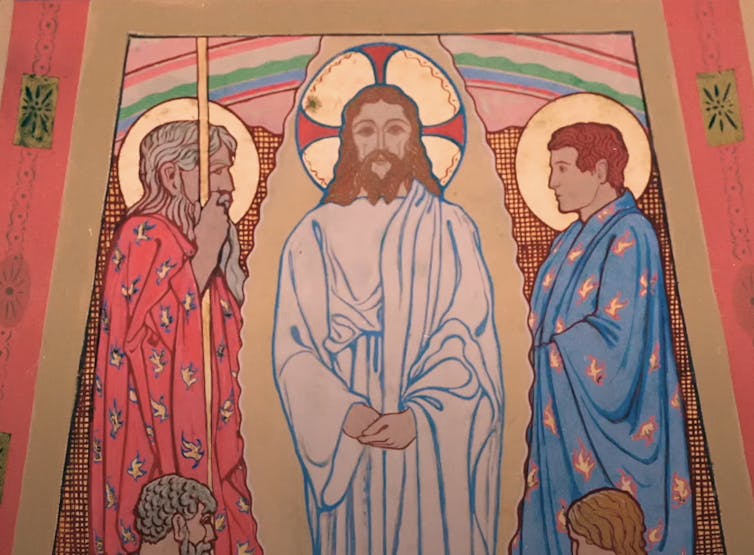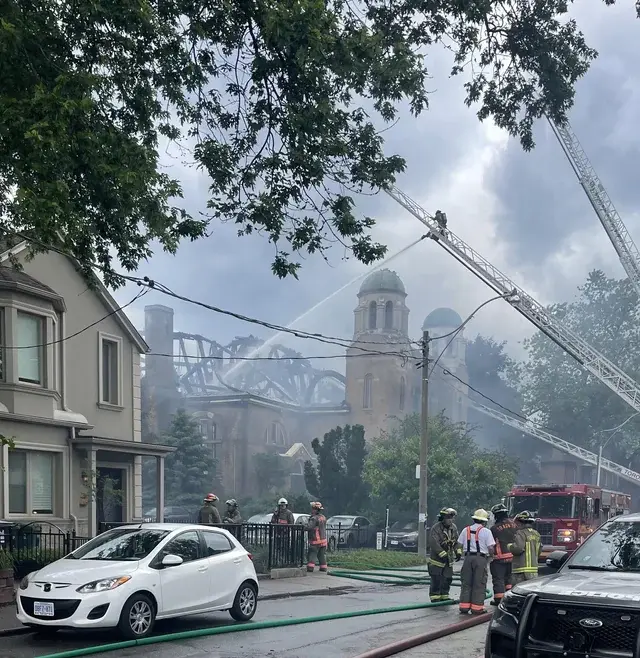The public reaction to the tragic fire that consumed St. Anne’s Anglican Church on Toronto’s Gladstone Street is remarkable on many levels.
Given how secular journalism covering religious communities continues to decline in Canada, the amount of television and newspaper coverage of the fire is striking.
Moreover, while the unique nature of the church’s design and artwork is heralded as a national treasure (the building was a designated as a National Historic Site), the church has struggled for decades to preserve the building and its murals.
Finally, despite being celebrated for its art treasures, a great deal of the media coverage has focused on the impact of the fire on church members and the local community. Beyond its own worship services, the church has engaged in community outreach and was also home to offices and a rehearsal space for a theatre group.
These dynamics bring into clear view the often-overlooked significance of space in contemporary cities and communities, and the impact a dramatic tragedy has on public imagination and community identity.
Buildings impact their surroundings
Built in 1908, St. Anne’s was immediately noteworthy, standing out for its Byzantine-style inspired by designs originating in the Eastern half of the Roman Empire (like Hagia Sophia in present-day Istanbul). This was in stark contrast to the architectural style typical of the Anglican tradition at the time, particularly the neo-Gothic approach to church design.
Architects remind us that buildings make statements and impact their surroundings. Was St. Anne’s intended to be a more Protestant-friendly expression of the Anglican Church than the prominent Anglo-Catholic style of the period? Or was drawing from Eastern Orthodox Christianity meant to inspire a vision of unity across different denominations?
The concept behind the design has remained a puzzle and been much debated by art historians like Marylin McKay and Peter Coffman.
As Coffman notes, when St. Anne’s was built, some Christian observers objected to the building’s dome because it made them think of a mosque or synagogue. This highlights the impact architecture can have on observers as it aligns or deviates from the attitudes and culture of the community it is located in.
Distinct artwork
In 1923, the peculiarity of St. Anne’s was enhanced by the commissioning of a team of artists from the Ontario College of Art to decorate the church interior with Byzantine-style art resembling eastern iconography more than dominant styles in western Christian art.
Much of the work was done by three artists (including J.E.H. MacDonald) who would become part of Canada’s famed “Group of Seven.” The result was a church building unique in Canada, leading many architectural historians to describe it as “irreplaceable.”
In recent decades, scholars have emphasized the significance of place for shaping community and identity. Environmental issues, the impact of globalization and the rapid pace of urban redevelopment have elevated the significance of place and geography, prompting new attention on the nature of human identity, belonging and the ethics of decisions over the use of shared space.
These reflections have heightened awareness of how power dynamics, cultural meaning and ecological implications affect decisions about the use of space in societies.
These considerations are also prominent in dialogues between Indigenous Peoples and their neighbours, in which the importance of the land and one’s relationship to nature are key themes.
Space as ‘social product’
As the French philosopher and sociologist Henri Lefebvre argued, space is not simply inherited from nature, but “is a social product.” Space is shaped by human activity, based on certain goals and preoccupations, and is thus not merely a neutral backdrop.
Lefebvre was particularly concerned with ways that modern capitalism encourages fragmented spaces that prioritize efficiency and consumption over community life and social interaction.
More recently, the German philosopher Peter Sloterdijk discusses space as the venue in which a sense of self is shaped and individual and communal identity formed.

(YouTube/St. Anne’s Church and the McMichael Collection of Canadian Art)
Lefebvre’s conception of space helps one understand how the idiosyncratic design of St. Anne’s reflected particular dynamics within Canadian society and culture at the time the church was built — including the impact of changing demographics, rising cultural diversity and local religious rivalries.
How we think about and value space
Lefebvre’s work also highlights how changes in the economy, urban planning and cultural norms modify how people think about, value and organize space. In the late 1990s, St. Anne’s struggled to pay to renovate its leaking roof. One question the St. Anne’s fire highlights is the nature of churches as sites of cultural heritage amid a decline of Christian affiliation in Canada.
Sloterdijk’s emphasis on how space shapes identity highlights how the loss of such space can result in a lost sense of identity. This resonates with a theme emphasized by the rector of St. Anne’s, Rev. Don Beyers, following the fire. Beyers describes disorientation and deep emotional turmoil experienced by members of the church and the surrounding neighbourhood. A connection to a place brings meaning to human lives. The loss of a cherished space is often not only painful, but even traumatic.
The St. Anne’s community will have to face navigating disaster beyond the emotional expression of comradeship and solidarity in the immediate aftermath, particularly once media interest fades.
The leadership of the church appear to be alert to this, and poised to respond. Nevertheless, navigating such disorienting emotional dynamics will be challenging.
Identity, space and environment
It will be interesting to observe whether the sudden appreciation for the significance of the St. Anne’s space will be lasting, or whether this recognition will quickly fade as the news cycle moves on and the redevelopment frenzy of urban Toronto resumes. Perhaps the media attention to the St. Anne’s fire signals that, at least to some extent, many Canadians are becoming increasingly attuned to connections between identity, space and the environment.
As the Osage theologian Tink Tinker writes, “a firm sense of filial attachment to particular place” is related to “a responsibility to relate to the land.”
If the tragic fire of St. Anne’s does indeed inspire people to be more attuned to such issues in Canadian society, then perhaps hope can indeed be found even amid this disaster. As Beyers has said in interviews, the people of St. Anne’s believe that new life emerges in the wake of death.![]()
Christopher Brittain, Dean of Divinity and Chair in Anglican Studies , Trinity College Faculty of Divinity at the University of Toronto
This article is republished from The Conversation under a Creative Commons license. Read the original article.






















